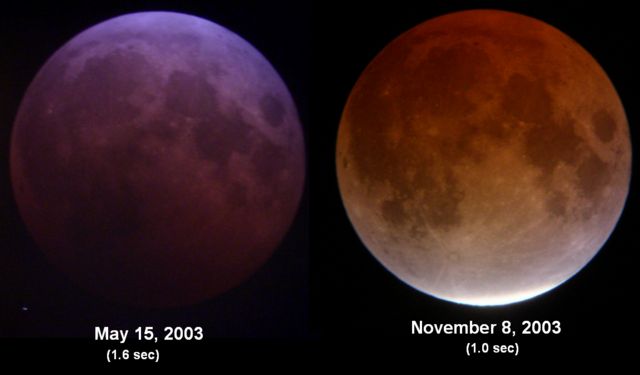Danjon Scale on:
[Wikipedia]
[Google]
[Amazon]
 The Danjon scale is a five-point scale useful for measuring the appearance and luminosity of the
The Danjon scale is a five-point scale useful for measuring the appearance and luminosity of the
 The Danjon scale is a five-point scale useful for measuring the appearance and luminosity of the
The Danjon scale is a five-point scale useful for measuring the appearance and luminosity of the Moon
The Moon is Earth's only natural satellite. It is the fifth largest satellite in the Solar System and the largest and most massive relative to its parent planet, with a diameter about one-quarter that of Earth (comparable to the width of ...
during a total lunar eclipse
A lunar eclipse occurs when the Moon moves into the Earth's shadow. Such alignment occurs during an eclipse season, approximately every six months, during the full moon phase, when the Moon's orbital plane is closest to the plane of the Earth ...
. It was proposed by André-Louis Danjon
André-Louis Danjon (; 6 April 1890 – 21 April 1967) was a French astronomer born in Caen to Louis Dominique Danjon and Marie Justine Binet.
Danjon devised a method to measure "earthshine" on the Moon using a telescope in which a prism spl ...
in 1921, when postulating that the brightness of a lunar eclipse was related to the solar cycle
The solar cycle, also known as the solar magnetic activity cycle, sunspot cycle, or Schwabe cycle, is a nearly periodic 11-year change in the Sun's activity measured in terms of variations in the number of observed sunspots on the Sun's surfa ...
. An eclipse's rating on the scale is traditionally denoted by the letter ''L''.
The scale
The Danjon scale is described in the following table:Determining the value of L
Determination of the value of L for an eclipse is best done near mid-totality with the naked eye. The scale is subjective, and different observers may determine different values. In addition, different parts of the Moon may have different L values, depending on their distance from the center of the Earth'sumbra
The umbra, penumbra and antumbra are three distinct parts of a shadow, created by any light source after impinging on an opaque object. Assuming no diffraction, for a collimated beam (such as a point source) of light, only the umbra is cast.
Th ...
.
Factors affecting the value of L
Many factors can affect the appearance of the Moon during a lunar eclipse. The Moon's path through the Earth'sumbra
The umbra, penumbra and antumbra are three distinct parts of a shadow, created by any light source after impinging on an opaque object. Assuming no diffraction, for a collimated beam (such as a point source) of light, only the umbra is cast.
Th ...
is important, but so too are the current conditions of the Earth's atmosphere
The atmosphere of Earth is the layer of gases, known collectively as air, retained by Earth's gravity that surrounds the planet and forms its planetary atmosphere. The atmosphere of Earth protects life on Earth by creating pressure allowing for ...
. While the Earth's shadow blocks any direct light from striking the Moon during a lunar eclipse, some light is refracted through the Earth's atmosphere giving the Moon a red hue.
The amount of light refracted affects the brightness of the moon at mid-eclipse, and this depends on several factors. Volcanic
A volcano is a rupture in the crust of a planetary-mass object, such as Earth, that allows hot lava, volcanic ash, and gases to escape from a magma chamber below the surface.
On Earth, volcanoes are most often found where tectonic plates a ...
eruptions are one of the most significant - eruptions which spew significant amounts of volcanic ash
Volcanic ash consists of fragments of rock, mineral crystals, and volcanic glass, created during volcano, volcanic eruptions and measuring less than 2 mm (0.079 inches) in diameter. The term volcanic ash is also often loosely used t ...
into the air are generally followed by several years of dark, deep red eclipses. The effect of the 1991 eruption of Mount Pinatubo
The 1991 eruption of Mount Pinatubo in the Philippines' Luzon Volcanic Arc was the second-largest volcanic eruption of the 20th century, behind only the 1912 eruption of Novarupta in Alaska. Eruptive activity began on April 2 as a series of ...
on subsequent lunar eclipses was very noticeable, with the eclipse of 9 December 1992 rated 0 on the Danjon Scale by many observers.
It is also thought that the solar cycle
The solar cycle, also known as the solar magnetic activity cycle, sunspot cycle, or Schwabe cycle, is a nearly periodic 11-year change in the Sun's activity measured in terms of variations in the number of observed sunspots on the Sun's surfa ...
has some effect on the darkness of lunar eclipses--indeed Danjon established the scale for this reason.
References
External links
* https://web.archive.org/web/20050823095028/http://sunearth.gsfc.nasa.gov/eclipse/OH/Danjon.html {{Lunar eclipses Lunar eclipses Scales